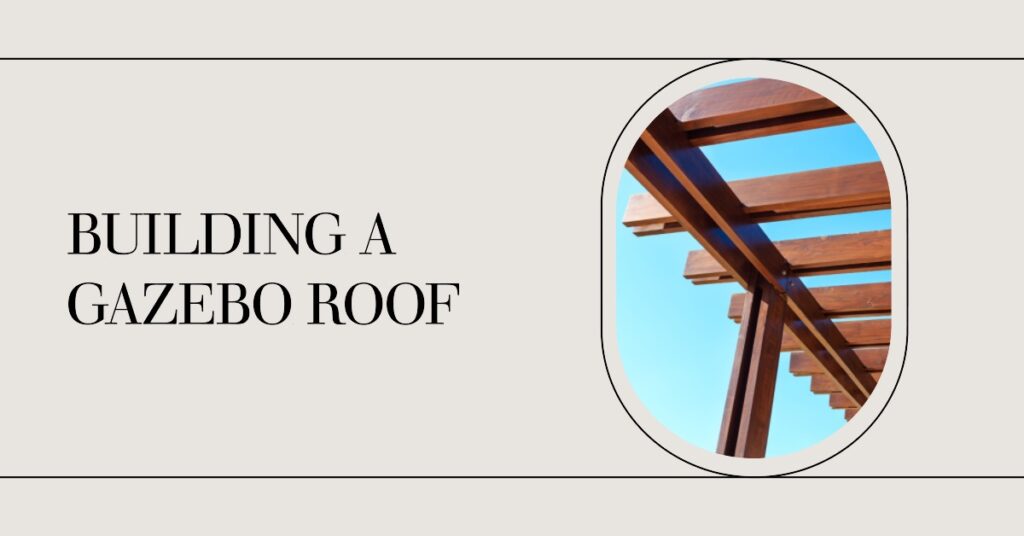Is your outdoor living space calling for a charming addition? Look no further than building a gazebo roof, the perfect centerpiece to elevate your backyard or garden. In this blog post, we will walk you through the A-Z of planning and constructing a gazebo roof that fits your needs and budget.
Whether you choose a wooden gable or an elegant octagonal design, our step-by-step guide provides expert tips on materials, techniques, and safety measures to ensure a successful DIY project.
Planning And Preparation For Your Gazebo Roof
Before starting to build your gazebo roof, it is crucial to plan and prepare by determining the type and size of your desired roof, obtaining necessary permits, setting a budget, and selecting appropriate materials.Consulting a professional roofing contractor can provide valuable insights and guidance, ensuring your project meets all safety and structural standards.
Choosing The Type Of Gazebo Roof
Before diving into the building process, it’s essential to decide on the type of gazebo roof that aligns with your tastes and the overall design of your outdoor space. There are several styles and materials to choose from, each offering unique benefits and aesthetic appeal.
In addition to aesthetics, consider practical aspects such as durability, maintenance requirements, local climate conditions, and budget when choosing your preferred material.
Wooden shingles or cedar shakes can add warmth and charm but may need more upkeep compared to metal panels like aluminum or steel sheets – especially in areas prone to heavy snowfall or strong winds.
If you’re looking for eco-friendly options, you could explore solar panel roofing materials.
Determining The Size Of The Roof
When building a gazebo roof, it is crucial to determine the appropriate size for your structure. This will largely depend on the size and shape of your gazebo, as well as its intended use.
For rectangular gazebos, measure the length and width of your base and add any desired overhangs or extensions to accurately calculate the dimensions needed for your roof.
It’s important not only to consider physical space but also aesthetics when determining roof size.
Another factor to consider is headroom – how much clearance you want above your head when seated inside? While standard height for most outdoor structures usually measures between 8-10 feet tall at their peak (this includes ridge beams), taller people might feel cramped inside so they might opt for higher roofs instead.
Remember: before making final calculations about what type of materials you’ll need in constructing an ideal-sized wooden, metal or shingle roof atop this garden feature – always double-check local permits and codes because they vary widely by area!
Obtaining Necessary Permits
It’s important to make sure you obtain all necessary permits before starting your gazebo roof project. This will ensure compliance with local regulations and prevent any expensive legal issues down the line.
Before beginning construction, do some research to find out what type of permits or approvals are required in your area. Typically, you’ll need a building permit from your city or county government.
To obtain these permits, start by visiting your local government office and speaking with someone in the building department who can guide you through the process. Be prepared to provide detailed plans for your proposed gazebo roof, including its size, location, and materials used.
Keep in mind that obtaining permits may take several weeks or even months depending on where you live and the complexity of your project.
Setting A Budget
Before starting any construction project, it is crucial to set a realistic budget to avoid overspending. When building a gazebo roof, the cost could vary based on the type of materials selected and size of the structure.
To help with budgeting for your gazebo roof, consider factors such as labor costs, transport expenses, permits fees (if applicable), and tools. You do not want to skimp on quality in favor of saving money since investing in durable materials offers long-term benefits.
For example, pressure-treated wood may be more expensive but has greater resistance against insect damage and rot compared to untreated wood that needs more maintenance over time.
Framing And Building Your Gazebo Roof
This section outlines the crucial steps to follow when framing and building your gazebo roof, including choosing the right materials, deciding on roof height and direction, installing rafters and roof supports, and attaching plywood sheets and trim.
Whether you’re a DIY enthusiast or seasoned builder, this guide is sure to provide valuable insights into building your dream gazebo.
Choosing The Right Materials
For your gazebo roof, it is crucial to choose the right materials. The material you use must not only be durable but also fit perfectly with your desired style and budget.
Wood shingles are a popular option as they are durable and provide an elegant look that blends in with nature.
Another vital factor to consider when choosing materials is weather resistance. Metal roofing sheets such as aluminum or copper may provide better protection against extreme weather conditions like heavy rain or snowfall than wood panels do.
You should also consider the type of framing material needed for your preferred roofing material.
In conclusion, selecting the right gazebo roofing materials requires careful consideration of factors like durability, aesthetics, weather-resistance ability, and overall cost-effectiveness.
Deciding On Roof Height And Direction
When it comes to building a gazebo roof, deciding on the height and direction of your roof is crucial in achieving the desired look and functionality. One important factor to consider is the overall aesthetic appeal of your gazebo.
For example, a high-pitched gable roof may be more appropriate for traditional or classic-style gazebos, while a flat or low-slope roof may work better for modern designs.
Another key consideration is the weather conditions in your area. If you experience heavy snowfall or strong winds, then a steeper pitched roof with a higher point may be necessary for increased durability and stability.
In conclusion, choosing an appropriate height and direction for your gazebo roof requires careful thought and planning based on various factors such as aesthetics, weather conditions, functionality needs and personal preference.
Installing Rafters And Roof Supports
Now that you have determined the size and height of your gazebo roof, it’s time to install the rafters and roof supports. Begin by measuring and cutting the required number of rafters for your structure, then attach them to the central support beam at even intervals.
Next, add additional supports between each rafter for added stability. These can be attached with wood screws or metal brackets, depending on your material choice.
Remember to prioritize safety as you work on this project – always use appropriate safety gear like gloves, goggles, and a hard hat when necessary. And if you need any help or guidance along the way, don’t hesitate to seek out professional assistance.
When designing a gazebo, it’s also crucial to understand the distinction between roof trusses and rafters. Roof trusses are suitable for larger structures with longer spans and no need for interior support columns. Trusses are often used in modern or spacious gazebos but can be more expensive to install.
Rafters, on the other hand, are inclined to support members that run from the exterior walls to the roof ridge. They are lighter and less complex than trusses, making them appropriate for smaller or traditionally styled gazebos. Rafters can be spaced closer together, creating a cozier ambiance, and they are generally more budget-friendly.
Your choice between trusses and rafters should consider your design preferences, budget, and local building codes, which may influence the type of roof structure allowed. Consulting with a professional like Hardie Boys is essential to ensure proper installation, safety, and functionality.
Attaching Plywood Sheets And Trim
Once the rafters are up, it’s time to attach plywood sheets to create a solid base for your gazebo roof. Before attaching Plywood Sheets and Trim, it’s essential to ensure that they’re cut into the right dimensions and shape according to your gazebo design plans.
Once in place, add trim around the edges of each sheet, making sure they overlap slightly over any seams between two adjoining pieces. This process will help seal gaps and give your gazebo roof added protection against weather elements such as wind and rain.
By following these simple steps, you’ll have successfully attached Plywood Sheets and Trim to complete yet another critical stage towards an impressive DIY Gazebo Roof fitted with long-lasting roofing materials like metal panels or roofing shingles depending on personal preferences!
Covering Your Gazebo Roof
After framing and building your gazebo roof, the next step is to cover it with tar paper before adding shingles or metal panels for added protection against the elements.
Applying Tar Paper
One important step when building a gazebo roof is applying tar paper. This serves as a protective layer between the plywood and shingles or metal panels that will cover the roof.
Tar paper is typically available in rolls and can be cut to size using scissors or a utility knife. It should be laid out over the plywood, starting at the bottom edge of the roof and overlapping each row by several inches to prevent water from seeping through any gaps.
It’s worth noting that some homeowners may choose to skip tar paper altogether if they opt for an alternative roofing material like metal panels that don’t require this additional layer of protection.
Adding Shingles Or Metal Panels
After applying tar paper on the roof of your gazebo, it is time to decide what type of roofing material to use. Shingles are a popular option for traditional wooden gazebos, while metal panels work well for modern designs.
When installing shingles, begin at the bottom edge of the roof and work your way up. Use roofing nails to secure each shingle in place, overlapping them as you go. For metal panels, make sure they are cut precisely and attached securely with screws or clips.
It’s important to take into account local building codes before choosing a roofing material as some areas may have restrictions on certain types of roofs.
Finishing Touches
Once the roof of your gazebo is complete, it’s time to add those final touches that will make your project stand out. Depending on the style and design of your gazebo, you may want to add decorative elements such as scalloped trim or painted accents.
Additionally, consider landscaping around your finished gazebo for an added touch of beauty. Planting colorful flowers or shrubs near the base can help blend the structure seamlessly into its surroundings while creating an enchanting atmosphere for relaxation and entertainment.
Lighting, curtains or drapes, outdoor furniture, plants and flowers, and decorative railing can all add aesthetic appeal to the structure. You can also consider upgrading the flooring with natural stone, pavers, or outdoor rugs.
Adding a ceiling fan for comfort, bug screens for insect protection, and wind chimes or bells for a soothing ambiance are other options. Hanging outdoor art and decor, installing a fire pit or fireplace, or setting up a sound system for entertainment are ways to further personalize the space.
Additionally, privacy screens or lattice panels can shield your gazebo, and personal items like family photos can add a personalized touch. Remember to choose finishes that match your gazebo’s style and are suitable for outdoor use.
Tips For Building A Gazebo Roof
Use high-quality materials for a durable and long-lasting gazebo roof, follow instructions diligently for optimal results, prioritize safety measures such as wearing protective gear during construction, and consider seeking professional assistance if necessary to ensure that the project meets all required standards.
Use Quality Materials
Using quality materials is crucial when building a gazebo roof. It ensures the durability and longevity of your structure, even in harsh weather conditions. When selecting materials such as wood and roofing sheets, be sure to choose those that are resistant to rotting, decay, and pests.
Quality materials will also require less maintenance over time compared to lower-quality options.
For instance, using cedar or redwood for the frame of your gazebo roof instead of pine or spruce can make a significant difference in terms of how long it lasts. Additionally, opting for metal roofing panels made of high-grade steel will protect your roof from rusting and corrosion over time.
Follow Instructions Carefully
It is crucial to follow the gazebo roof building instructions carefully to avoid mistakes that can lead to unwanted consequences. When starting a DIY project, it’s tempting to jump right in and start building without paying close attention to details.
One great way of ensuring you are following the instruction correctly is by reviewing them before beginning any construction work. Take good note of every detail and understand what is expected at each step.
It would be best if you also had all necessary tools ready beforehand so that you don’t misplace any key components while assembling the gazebo structure.
Prioritize Safety Measures
Safety should always be a top priority when building your gazebo roof. It’s important to wear protective gear like gloves, goggles, and a hard hat when working with power tools or heavy materials.
Additionally, it’s crucial to ensure the structural integrity of your gazebo roof by using quality materials and following instructions carefully. Don’t cut corners or try to rush through steps; take your time to do each step correctly.
If you’re unsure about any aspect of the construction process, seek professional assistance before proceeding.
Seek Professional Assistance If Needed
If you feel that building a gazebo roof is beyond your skill level or if you simply do not have the time to devote to this project, it may be wise to hire a professional.
An experienced contractor can help ensure that your gazebo roof is built correctly and safely, maximizing its longevity and functionality.
Before hiring anyone, however, take some time to research local contractors in your area. Look for those with experience in building gazebos or outdoor structures similar to yours.
Ask for references or examples of their work so you can see what they are capable of.
Remember that seeking professional assistance does come at an additional cost, but it may ultimately save you money due to less waste from mistakes made during construction as well as the reduced risk of injury on the job site.
Conclusion
Building a gazebo roof is a great DIY project that can add beauty and functionality to your outdoor living space. With careful planning, quality materials, and attention to safety measures, you can successfully build your own gazebo roof.
Remember to choose the right type of roof, obtain necessary permits, set a budget, use quality building materials, and follow instructions carefully. And don’t forget to prioritize safety measures! If you’re unsure about any aspect of the project or need professional assistance, don’t hesitate to seek help.
Related Posts
How to keep birds out of my gazebo
Can you put solar panels on a gazebo
What’s the difference between a gazebo and a pavilion
Where to put a gazebo in the backyard
How to keep a gazebo from blowing away
How to hang lights in a gazebo
How to hang gazebo curtains
How to screen a gazebo
How to level a gazebo on sloped concrete
What to do with an old metal gazebo frame
How to move a gazebo
Do you need a permit for a gazebo
How to build a gazebo on a deck
How to anchor a gazebo without drilling
How to decorate a gazebo for a wedding
How much does a gazebo cost
What is a gazebo used for
What is the difference between a gazebo and pergola









